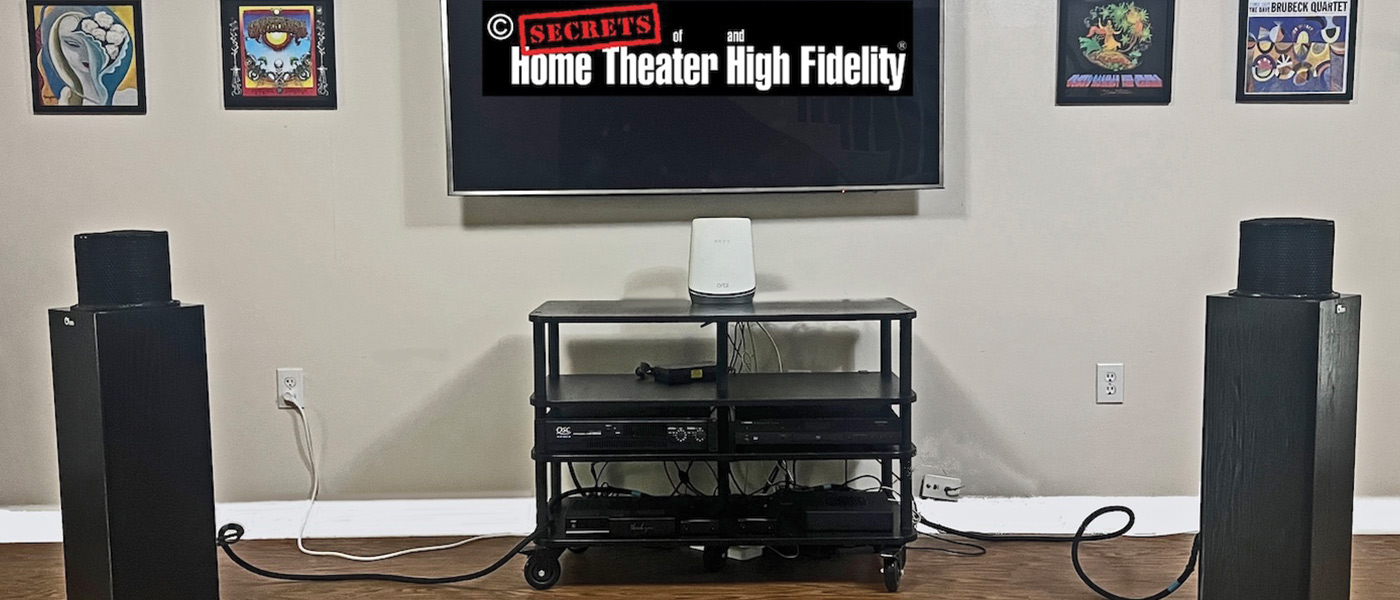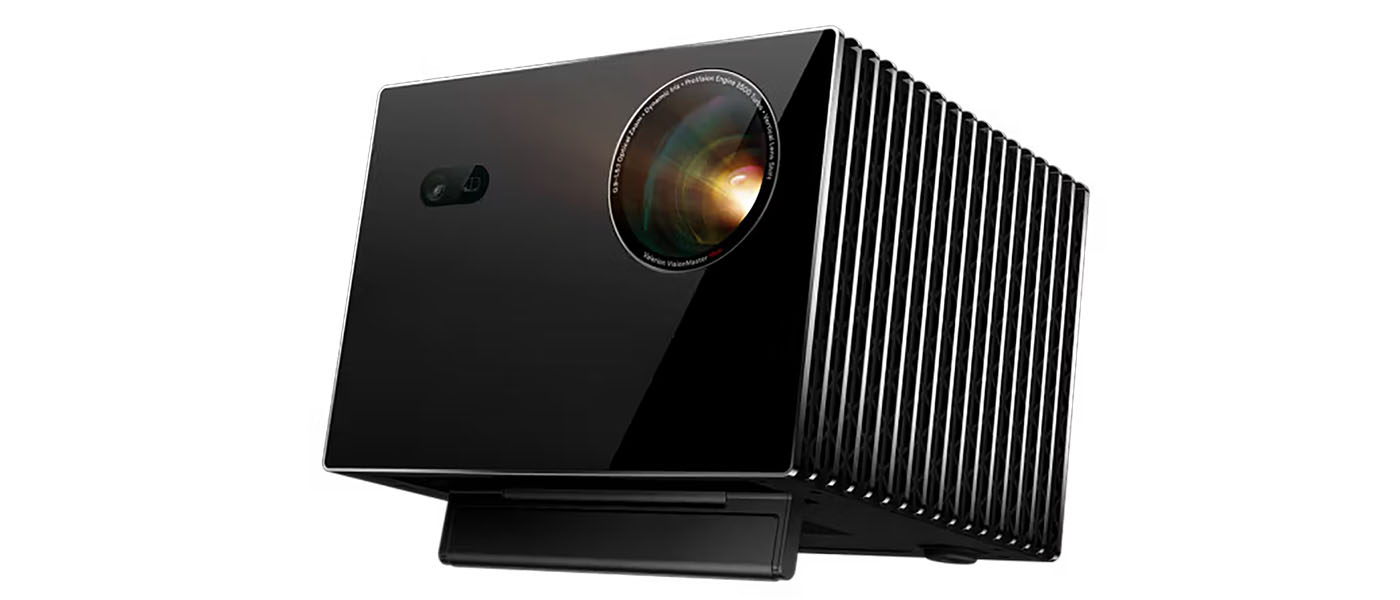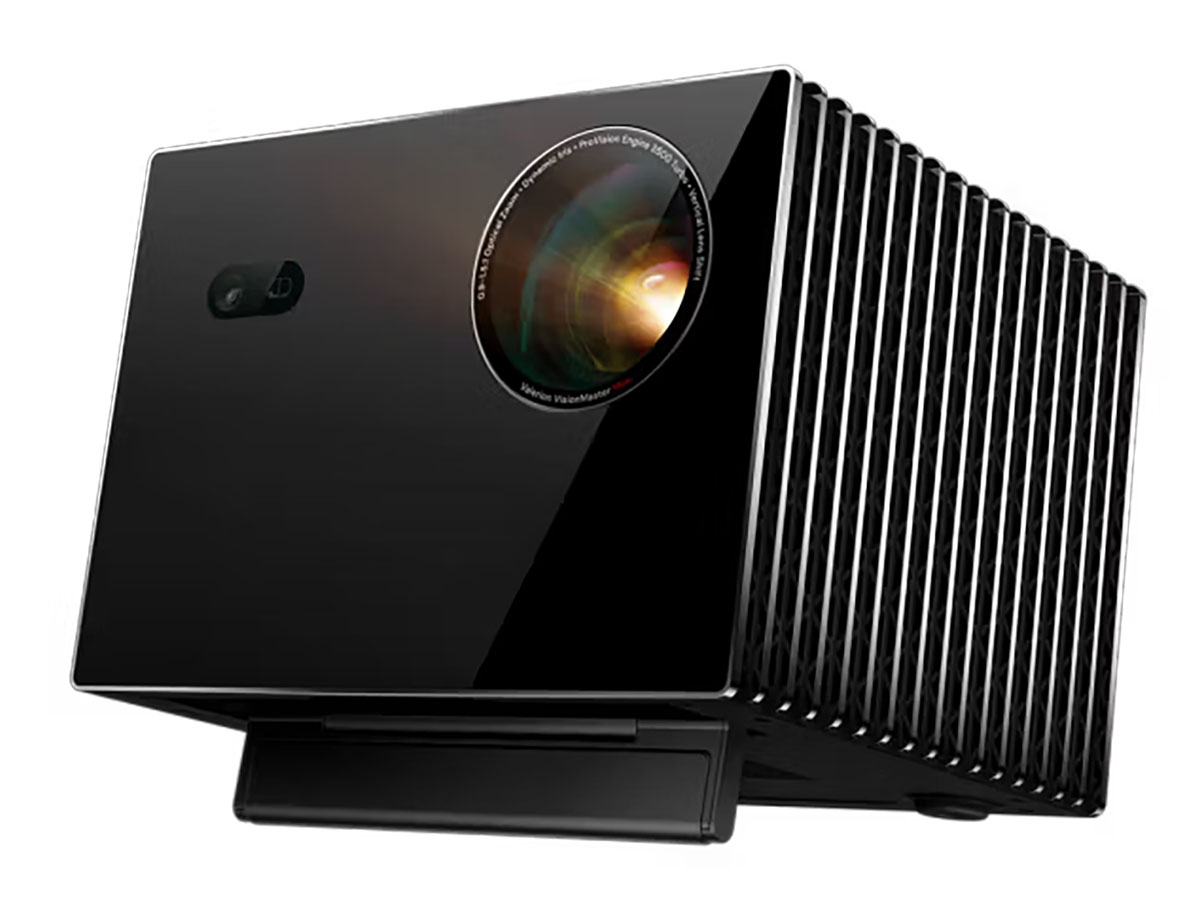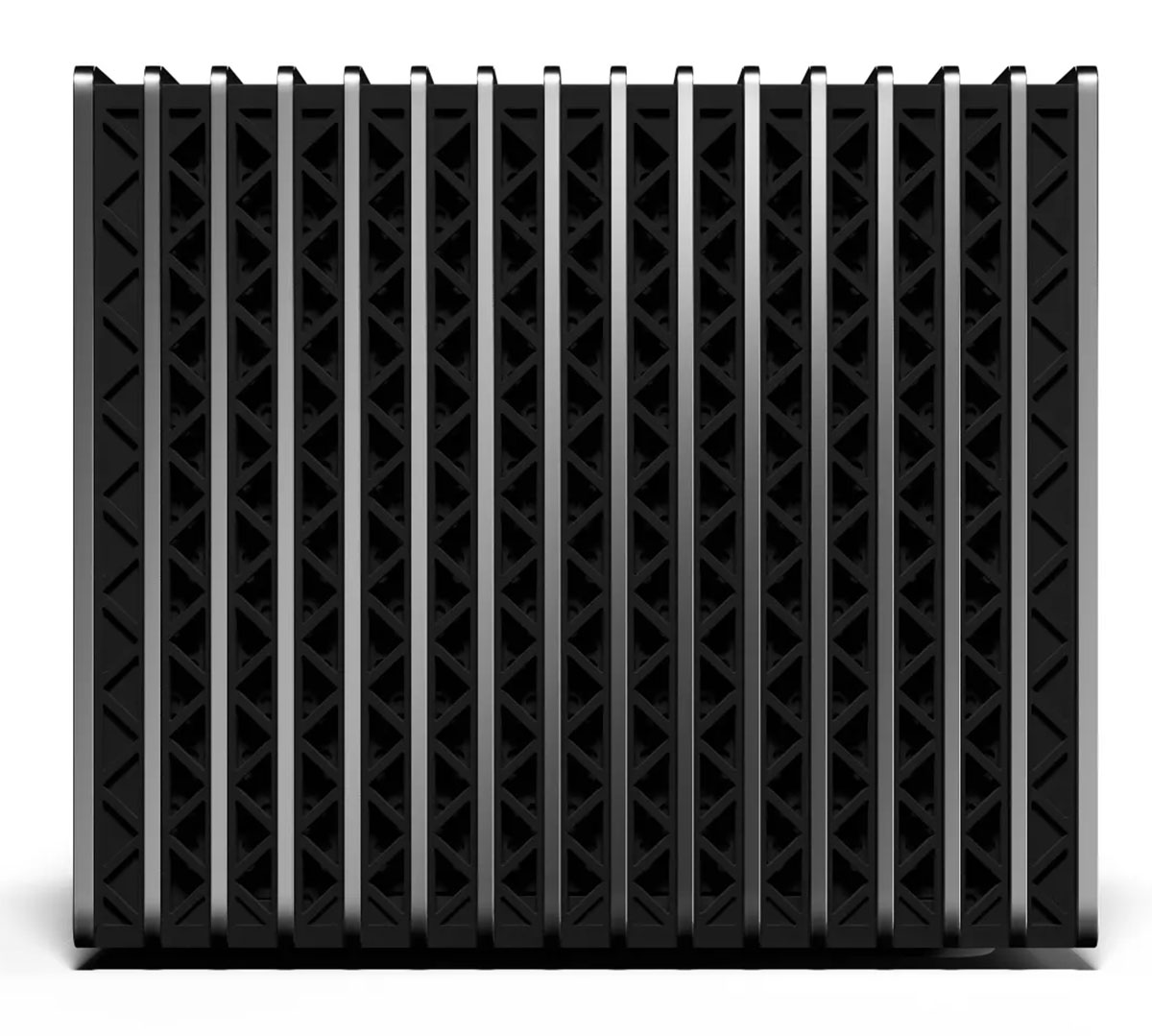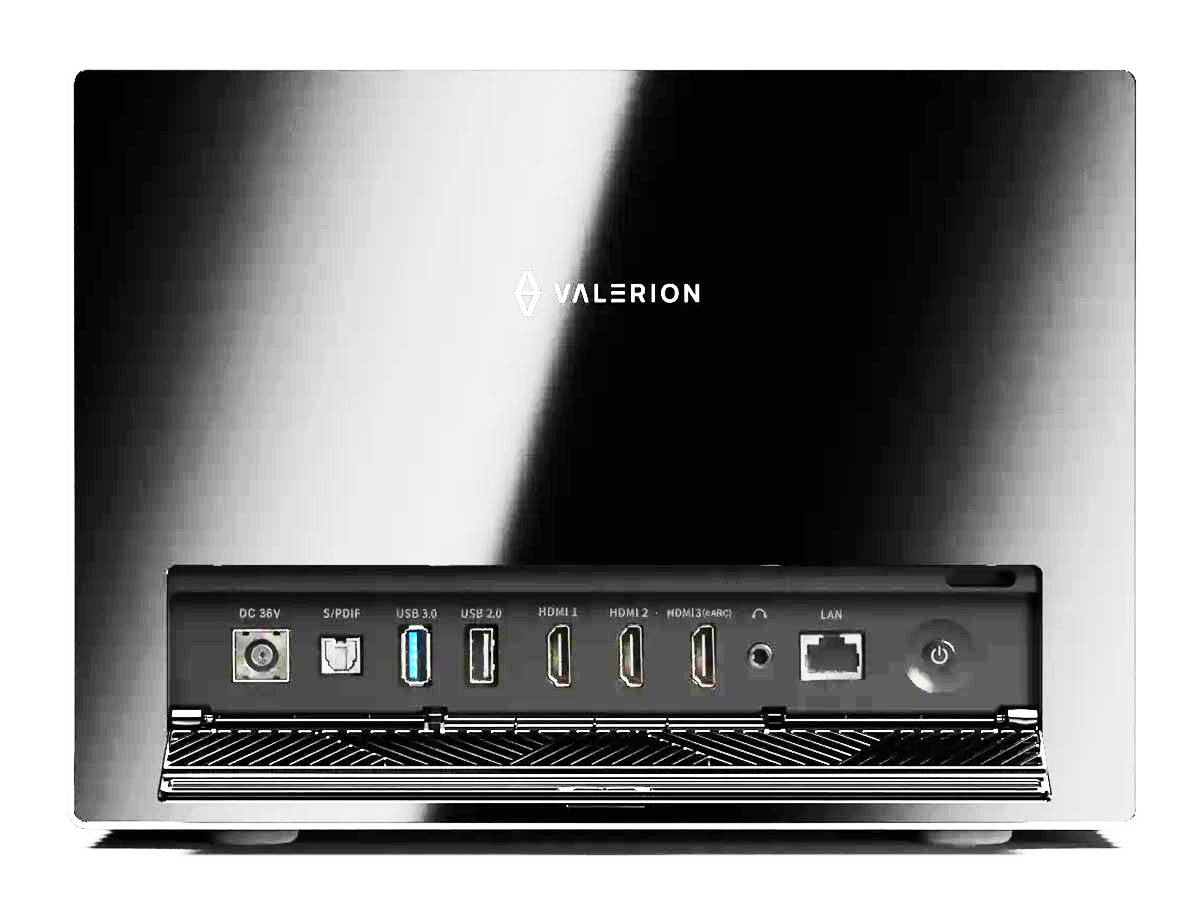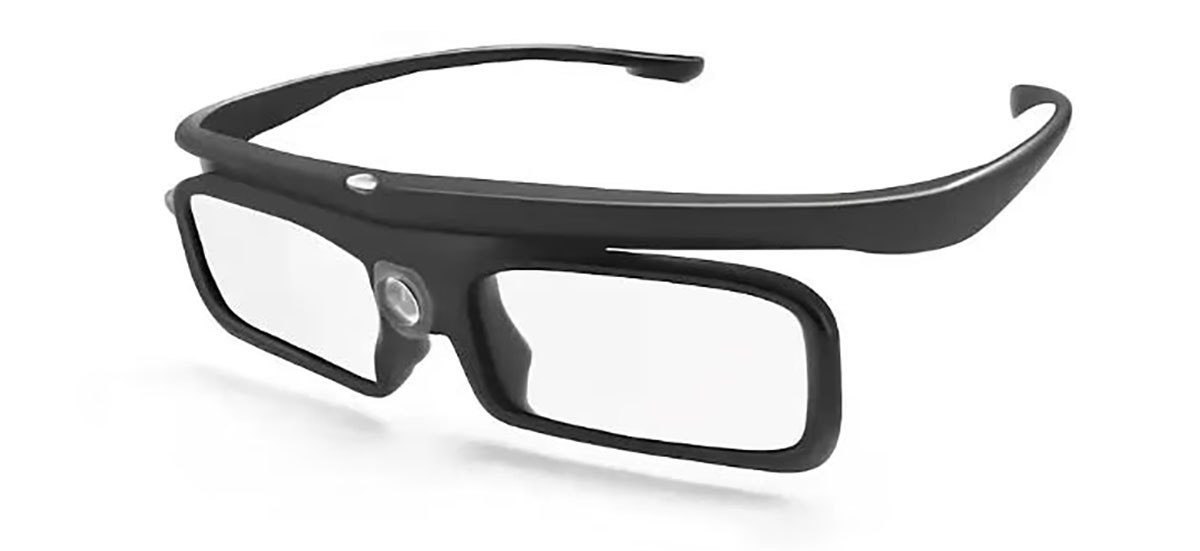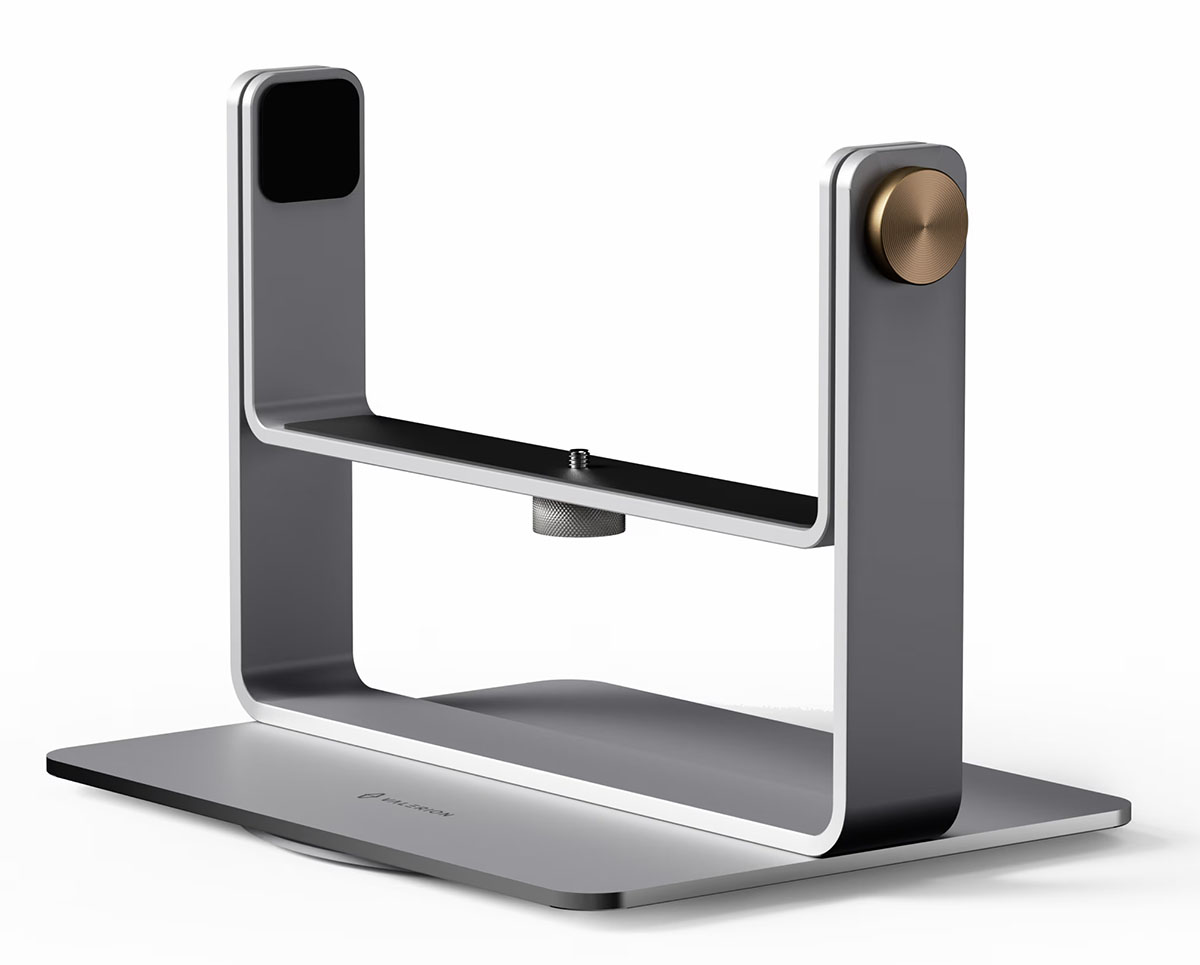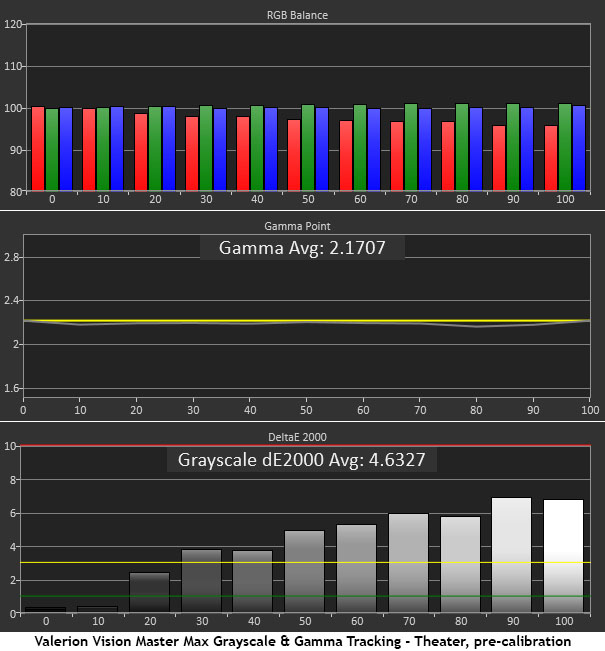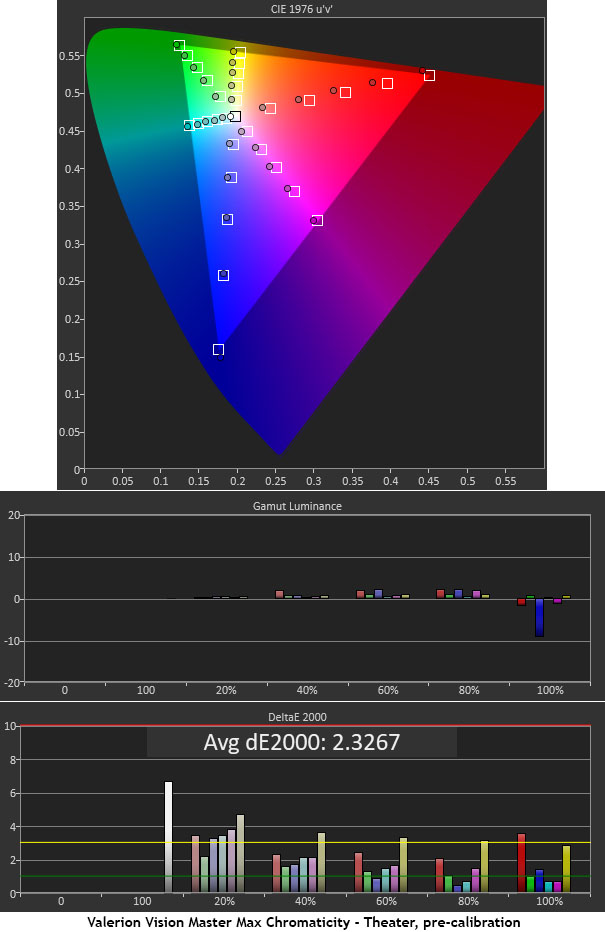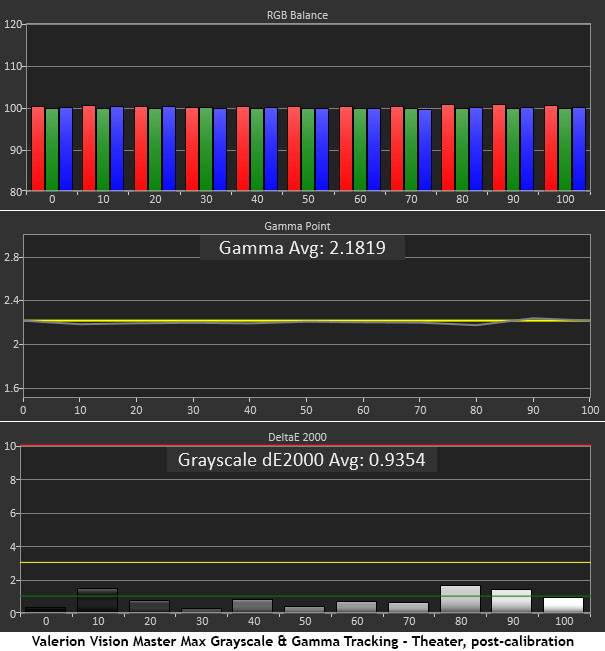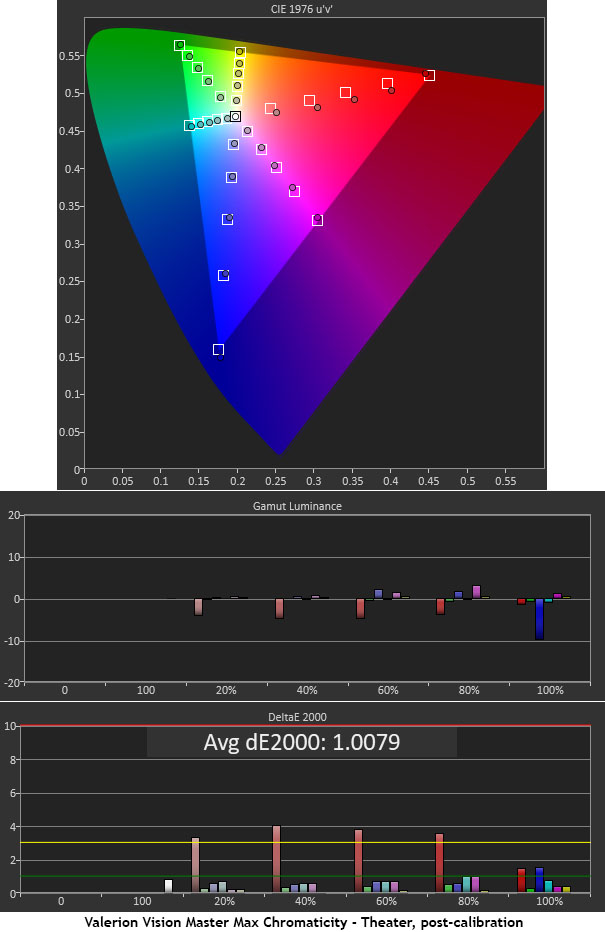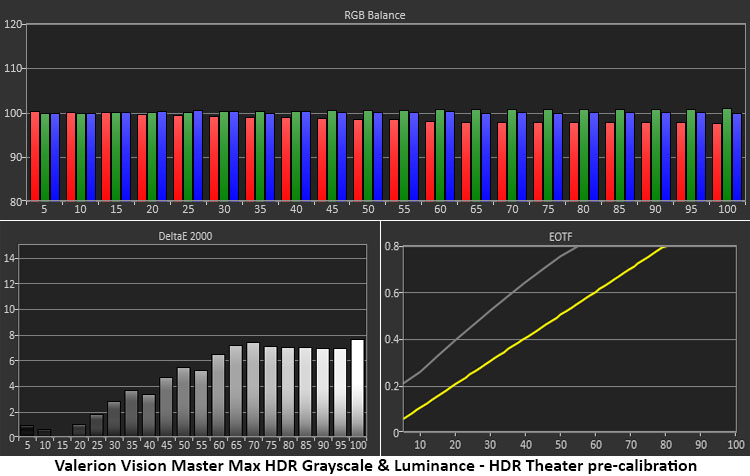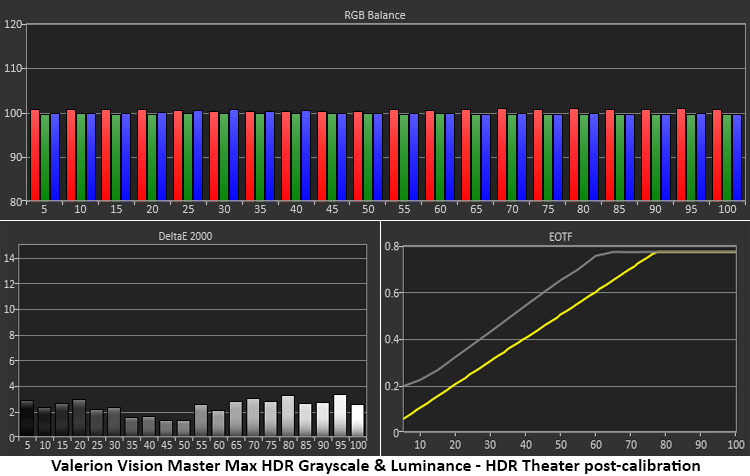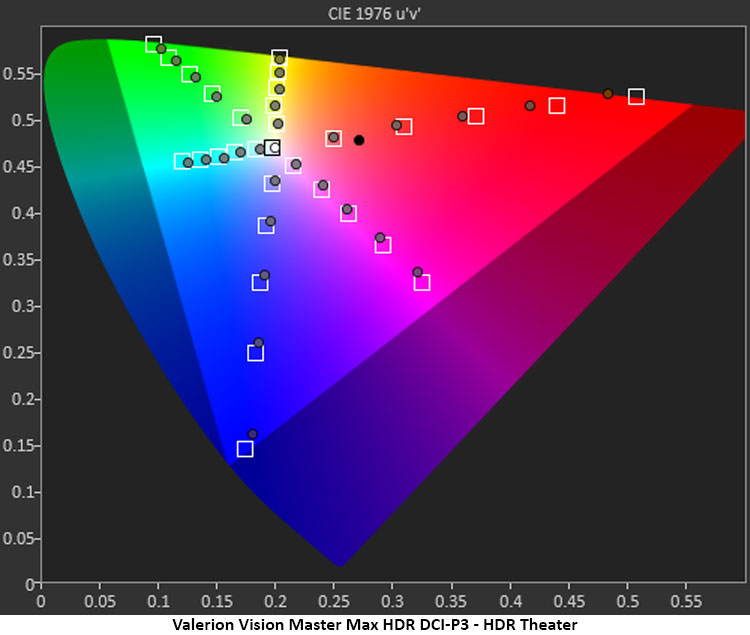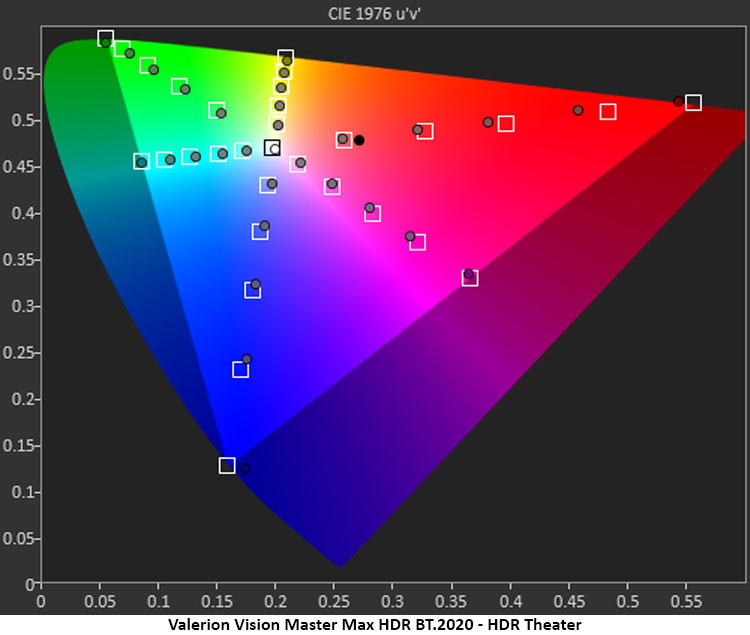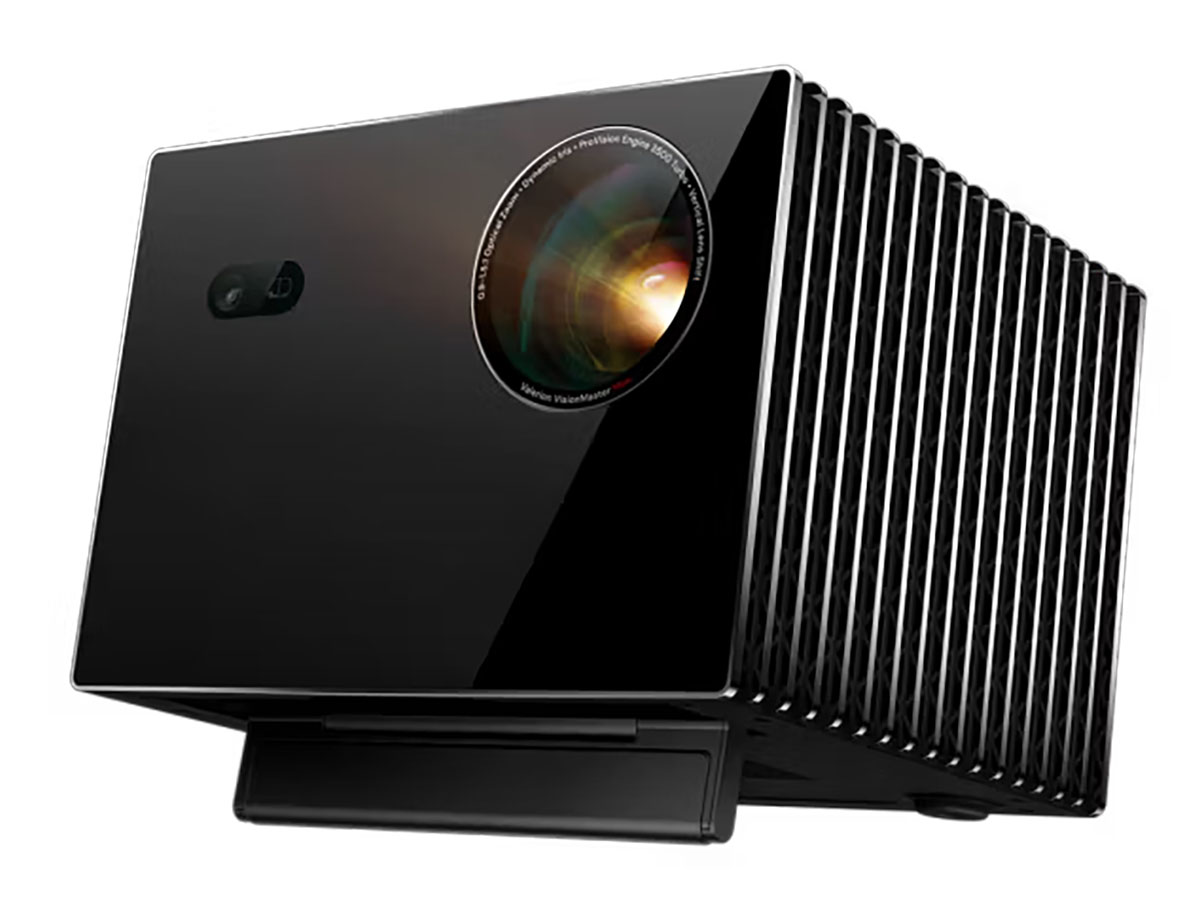Its tri-laser DLP light engine delivers 3,500 lumens and a huge color gamut.
The Valerion VisionMaster Max is an Ultra HD DLP projector with a tri-laser light engine. It delivers 3,500 lumens, a huge color gamut, 4K resolution, automated lens shift, zoom and focus, automatic geometry correction, Google TV, integrated audio, (take a breath), and an elegant design in a compact chassis for $4,999. It’s a flagship product that checks all the boxes and hits all the marks right out of the gate.
Valerion VisionMaster Max Projector
- Tri-laser DLP Ultra HD projector
- 3,500 lumens with BT.2020 color
- HDR10, HDR10+, Dolby Vision, HLG, Dynamic Tone Mapping, IMAX Enhanced, and 3D support
- Automatic focus, zoom, and lens shift
- Automatic keystone correction
- Two 12-watt internal speakers
- Three HDMI inputs
- Google TV with integrated Wi-Fi
- Chromecast, Alexa, Miracast, Google Home, Apple HomeKit, Control4, Bluetooth, and AirPlay 2
I usually comment about a projector’s styling in my reviews, devoting perhaps one or two sentences, then moving on to more technical details. But Valerion’s VisionMaster Max deserves a bit more attention. When I requested the sample for review, the photos intrigued me, and when I unboxed it, I was beyond impressed. I’ll get into those details later, but just to whet your appetite, it is one of the most beautifully designed projectors I’ve ever had the pleasure to experience.
OK, technical details. It’s an Ultra HD projector with a single chip DLP tri-laser imaging engine, 3,500 lumens, BT.2020 color, HDR in every flavor, IMAX Enhanced, 3D, Google TV, integrated speakers, automatic lens and geometry controls, (pause for effect), jeez, what doesn’t it have? It’s just hitting the market with full production available around the time you read this. Let’s take a look.
Type:
Single-chip 0.47” DLP with tri-laser engine
Resolution:
3840 x 2160, 1920 x 1080 @ 120 & 240 Hz
HDR:
HDR10, HDR10+, HLG, Dolby Vision
Service life:
25,000 hours
Light output (mfr):
3,500 Lumens
Throw ratio:
0.9-1.5:1, 0.9-2.0:1 w/addon lens
Lens shift:
105% vertical, 15% horizontal
Video connections:
2x HDMI 2.1, 1x HDMI 2.0 w/eARC/ARC
Additional connections:
2x USB-A, 1x 3.5mm audio, 1x optical output, 1x RJ-45
Speakers:
2x 12 watts
Dimensions (W x H x D):
10.2” x 7.3” x 9.2”
Weight:
16.5 lbs.
Warranty:
2 years
Price:
$4,999.00
Company:
SECRETS Tags:
valerion, visionmaster max, laser projector, dlp projector, home theater projector, ultra hd projector
- Epson QL7000 4K HDR High-Lumen 3LCD Laser Projector Review
- BenQ GP520 4K Living Room Projector Review
Secrets Sponsor
Normally, I’d talk about the unboxing in the next section of the review, but it’s really cool, so I’ll do it now. The shipping carton showed up looking like it had taken an arduous journey and was about 50% covered in tape, so I figured someone else had reviewed it before me, not unusual.
Opening this revealed the main box, which was covered in leather, or a darn good facsimile of that material, because it even had the smell of a fine hide with actual stitching holding it together. If I didn’t know better, I’d think I had received a Rolex watch. The interior was lined with felt, and the projector was nestled in dense, flexible foam.
Removing the VisionMaster Max from its bag instantly gave me iPhone vibes. The cube-shaped chassis is made from metal and thick acrylic. It’s small but quite hefty at 16.5 pounds. The lens is offset behind a single clear panel with IR and position sensors opposite. Underneath is a flip-out “prop/foot/thingie” if you need to angle it upwards. The sides are all vented with no light leakage and a whisper-quiet fan.
The back is also smooth and unblemished, with the inputs behind a little door that flips down. The connections comprise two HDMI 2.1, one HDMI 2.0 with eARC, optical and 3.5mm audio outputs, two USBs, and an RJ-45.
The remote is a metal handset that exudes quality. It’s partially backlit and includes one-button access for YouTube, Netflix, Prime Video, and Disney+. The home button takes you straight to Google TV, which you can configure for your favorite streaming services by downloading the appropriate apps. It has a mic for Google Assistant and Amazon Alexa. It controls the VisionMaster Max via IR and Google TV with Bluetooth.
Valerion shipped me its 3D glasses with the sample. They are a minimalist design and are very light and comfortable. They’re reasonably priced, too, at $80 for two pairs. They don’t reduce brightness as much as the ones I usually use from Xpand, and that bought me around 50% more light when watching 3D content.
Inside, the VisionMaster Max has a 0.47” DLP chip with pixel shift to hit 3840 x 2160 resolution. A tri-laser light engine delivers 3,500 claimed lumens and full coverage of the BT.2020 color gamut. The lens is fully motorized and automated for focus, zoom, shift, and geometry. Using sensors on the projector, the picture literally adjusts itself on startup, or whenever you move it. This is super cool because it eliminates the tweaking normally needed when setting up a projector. You can defeat the automation if you like and set the parameters manually if you want to fine-tune.
The VisionMaster Max supports pretty much everything video and audio up to Dolby Vision and Dolby Atmos, along with IMAX Enhanced, 3D, HDR10+, HDR10, HLG, and DTS:X. Dynamic tone mapping is offered for the fixed luminance data found in HDR10 content.
The throw ratio is 0.9-1.5:1, which qualifies as short throw. You can project an image up to 300 inches diagonal, and for my testing, a 92-inch image came from a seven-foot projection distance. That means 100 inches from the average coffee table. If you need to angle it upward, the aforementioned foot flips out, and the keystone corrects automatically. Valerion offers a swiveling tabletop stand, ceiling mount, and tripod as additional mounting options.
Valerion sells six different screens ranging in price from $269 for a matte white 100” material with a simple frame to a 120” outdoor one that rolls into a motorized housing for $1,299. I got one with my sample, the Ambient Light Rejecting (ALR) model with a Fresnel surface. Though these are usually used for ultra-short throw projectors, they also work with longer throws and provide a nice bump in contrast by eliminating 85% of the light from above and from the sides. The material is rollable but semi-rigid, which creates a very flat surface for the image. The frame material is extruded aluminum with quality hardware to hold it together. I noted its fine construction, but did not use it for the review.
The VisionMaster Max has a threaded socket on the bottom for a tripod, so I hauled out my trusty Bogen, which could support a Honda Civic, and bolted the projector in place. I powered it up and watched as the automatic routine squared, sized, and focused the image. The focus was spot on, but the zoom and geometry had a little trouble with the super-thin border around my Stewart Filmscreen Luminesse screen. It got close, then I tweaked it into place manually.
Google TV is the default source, so I let the projector update its software and install my go-to streaming apps, which I selected from a list. This took about 10 minutes in total. The remote includes a source selection key, so I switched over to a pattern generator for the final setup and calibration.
There are six image modes, each for SDR and HDR, plus Dolby Vision Bright, Dark, and Custom. HDR10 and HLG can employ Valerion’s dynamic tone mapping to emulate Dolby Vision. You can also turn on HDR emulation for SDR content, which alters gamma to increase perceived contrast.
The color gamut is enormous and provides full coverage of BT.2020, one of the few consumer displays that does so. You can set the color space to Auto and see the correct gamut for SDR and HDR, or turn on the wide gamut for all content if you prefer.
The menu system is Google TV standard and will be familiar to those who have seen it on other displays. It occupies most of the screen, but when making adjustments, it drops down to the bottom to leave room for color meters. It has a full set of calibration options, including two and 20-point RGB, gamma editors, color management, and video processing features like frame interpolation and noise reduction.
One feature I had not seen before was Rainbow Effect Reduction. Some users are sensitive to the DLP rainbow effect, especially when the color wheel doesn’t spin at high speed. I don’t see it unless I project a scene with bright white highlights like a starfield and flick my eyes left to right. Valerion’s technology works as advertised. When I turned the RBR on, I could not see rainbows, no matter how hard I tried. And it had no visible downside. The picture was always razor sharp. This is a significant breakthrough that you won’t find elsewhere.
To control the light level, there is a 10-step laser power slider and a mechanical iris. The iris has two fixed presets and a manual setting with seven stops. Closing it down dims the image and increases contrast.
My first impressions of the VisionMaster Max centered around its incredibly clear image. It’s one of the sharpest projectors of any kind that I’ve experienced. To get the best picture, I had to experiment with the various options in the clarity and luminance menus. Clarity has both general and MPEG noise reduction; they are best set to low. Higher settings smooth over the finest details. Frame interpolation is also available, and it’s fine for sports, but movies and TV shows suffer from the soap opera effect, so I left it off. Finally, there is an Active Contrast option that should be set to low for the deepest blacks.
The best-looking content, as usual, is Dolby Vision, which I found on No Time To Die. The DV Bright mode worked fine for this with deep blacks, rich shadow detail, and bright highlights. Color is the star, though with incredible saturation and vivid hues. The VisionMaster Max is extremely colorful with its massive BT.2020 gamut.
I found that HDR10 content like Deadpool 2 was less impactful. It still had the fine detail and rich color, but contrast was only a little better than typical SDR content. During testing, I noted light luminance tracking, which was responsible for what I saw. With Dynamic Tone Mapping turned on, it improved slightly, but there is still some upward potential there. Don’t get me wrong, it still looked better than SDR.
Speaking of which, I sat down for a viewing of an old favorite, The Hunt For Red October. This classic from 1990 gets a decent Blu-ray encode with plenty of film grain to help date it. The noise reduction helped here with just enough correction to clean up the crawlier bits. SDR color looked great with vibrant and warm flesh tones against the cold blues of steel and sea. Contrast was solid as well after I set the same options for SDR as I had for HDR. Active Contrast is very effective. I tried the HDR emulation and found it made subtle changes that weren’t better or worse, just different. Use it at your own discretion.
The VisionMaster Max’s Google TV interface is perfectly integrated and appears with a press of the remote’s home button. YouTube offers some spectacular 8K footage that is just dripping with color. It’s a great way to show off the Max’s incredible gamut coverage, and it’s super sharp. Other SDR videos shone brightly with excellent color, though their quality varies. This projector is a neutral display, which means it won’t make poorly shot material look better.
Netflix has a huge selection of Dolby Vision content, so I watched a few episodes of the new season of Wednesday. This show is heavily smoothed in post-production, so I turned off the noise reduction, which added a bit of pop back into the image. Color was dramatic and again made the perfect vehicle to show off the Max’s capabilities. I also watched Full Speed, the NASCAR documentary, which has a more realistic color palette. It truly showed how good this projector is at sports footage. SDR content from Discovery+ included a new season of Food Network’s Triple Threat. The Max is a superb television replacement, especially in a darkened room.
For all the viewing described above, I used the Max’s internal speakers, which are excellent. They won’t shake the room, but they are super clear and provide decent bass. You won’t have to nail down loose objects, but there is enough happening down low to make dialog sound full and rich. There’s plenty of volume available, too. If you sit close to the projector, you’ll only need about 25% of the available amplitude. I also noted a reasonably wide sound stage and good dynamics with a broad range from soft to loud.
Secrets Sponsor
To test the VisionMaster Max, I set up my usual suite of benchmarks using the latest version of Calman from Portrait Displays. To measure color, I used an X-Rite i1 Pro Spectrophotometer, and for luminance, an X-Rite i1 Display Pro tri-stimulus colorimeter. Signals were generated by an Accupel DVG-5000. HDR signals were generated by the same unit with an HD Fury Integral in the signal path.
SDR Tests
Visual observation showed Theater mode to be the best starting point for calibration. It has slightly cool but decent grayscale tracking and ruler flat gamma.
You can see slightly reduced reds in the brightness steps above 40%. This lends a cool tone to the image, but it isn’t too far off the mark. Perfect gamma tracking means calibration won’t be difficult.
The color gamut is also close to standard, with full coverage of BT.709 for SDR signals. Luminance levels are perfectly balanced, with just 100% blue being a little less bright. You can see slight undersaturation in red and magenta, and hue errors in the yellow secondary. This is solid out-of-the-box performance.
The VisionMaster Max has two- and 20-point RGB sliders, but I only had to adjust the gains of the two- point control to get all grayscale errors below 2dE. Gamma remained perfect with no change to any luminance levels. There’s a 20-point gamma editor available, but I didn’t need to use it.
I worked with the color management controls for red to increase saturation, but it also introduced a slight hue error towards orange. This is impossible to spot in content, and ultimately, the image looked better than before, so I accepted this compromise. With a total error of just 1.01dE, I can’t complain. This is excellent performance.
HDR Tests
I used the VisionMaster Max’s HDR Theater mode to measure and calibrate HDR10 signals. It too is decent out of the box, with some improvement available through adjustment.
You can see the same slightly cool tone to the default HDR chart. It isn’t too far off the mark. Luminance tracking is quite light, however. This is with all dynamic options turned off.
I successfully calibrated the grayscale with the 2-point control. Though there is a 20-point option, it only addresses specific brightness steps and cannot be used to correct every error. No matter, because I removed all visible errors using just the gain sliders. The EOTF is still too light, though. I tried many combinations of dynamic tone mapping and dynamic contrast, and what you see above was the best I could achieve. The image looks pretty good, but some highlight areas are clipped of fine detail. The HDR image is bright and contrasty but has room for improvement.
The VisionMaster Max’s HDR gamut is excellent, with perfect hue tracking of all six colors. There is slight undersaturation in red, but not enough to negatively impact the picture. In the BT.2020 test, there is nearly full coverage of that gamut. This is one of only a handful of displays that can render so much color. This is plain to see in both test patterns and actual content. Color me impressed.
Brightness & Contrast
To measure luminance and contrast, I set the meter 10 feet back from a Stewart Filmscreen Luminesse with Studiotek 130 material, gain 1.3. The VisionMaster Max has plenty of light output but can also be adjusted for good balance in light-controlled rooms with a manual iris and a 10-level laser control. I’ll start with the HDR results.
HDR Theater, Laser 10, Dynamic Tone Mapping On
● White – 396.228 nits
● Black – 0.1342 nit
● Contrast – 2,951.7:1
SDR Theater, Laser 10, Dynamic Options Off
● White – 328.0987 nits
● Black – 0.1338 nit
● Contrast – 2,452.8:1
Vivid Mode (Maximum Output)
● White – 402.4888 nits
● Black – 0.1097 nit
● Contrast – 3,668.6:1
3D Frame Pack w/provided glasses
● White – 50.7322 nits
● Black – 0.0457 nit
● Contrast – 1,109.1:1
I noted that 3D brightness was a bit better than most, thanks to Valerion’s glasses, which don’t cut as much light output as the Xpand ones I usually test with. I also noted that there was no measurable crosstalk in 3D test patterns. This makes the VisionMaster Max one of the best 3D projectors I’ve experienced.
Settings
● SDR Mode Theater
● Contrast 40
● Black Level 0
● Gamma 2.2
● Color Temp Warm1
● Colorspace Auto
● Sharpness 15
● Super Resolution off
● CMS Red H-3 S8 B-3
● 2-point gain R6, G-4, B2, offsets all 0
● HDR Mode Theater
● Contrast 50
● Black Level 0
● Active Contrast High
● Dynamic Tone Mapping On
● Color Temp Warm1
● Colorspace Auto
● Sharpness 15
● Super Res off
● 2-point gain R3, G-10, B-8, offsets all 0
The Valerion VisionMaster Max Projector delivers high performance in a premium package while including support for absolutely every kind of video and audio content.
- Razor-sharp image
- Tremendous color coverage
- Slick automated lens and geometry adjustments
- Comprehensive calibration options
- Gorgeous physical design with premium materials
- Excellent audio quality
- Better luminance tracking for HDR10
The Valerion VisionMaster Max is a seriously impressive projector. It’s a premium model with a premium price, but it supports absolutely every video and audio format while pumping out more color than nearly every other display on the planet. Only a handful of consumer models cover BT.2020, which puts the Max in a very small group.
If design is important to you, there are few projectors that can compete. Its compact cube shape, metal & acrylic construction, and elegant look will be right at home in a high-end theater or media room. And it can be mounted on the ceiling, set on a table, or bolted to a tripod or swivel base.
I loved the automatic lens and geometry features. This takes a lot of the hassle out of installing a projector, especially if you don’t want to leave it out on the table. Just plop it down, turn it on, and let the tech do the work. And it’s bright enough for just about any environment and flexible enough to excel in a multi-use media room or a light-controlled theater.
The Valerion VisionMaster Max is super cool in many different ways, but at the core, it’s a performer that will satisfy picky videophiles like me. If you want a unique display and have $4,999 in your budget, definitely check it out.


